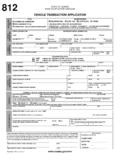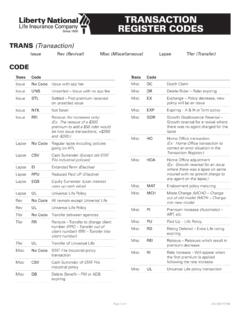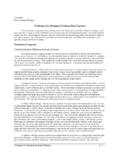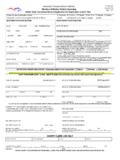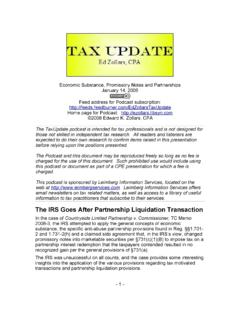Transcription of LB&I International Practice Service Transaction Unit
1 LB&I International Practice Service Transaction Unit IPS Level Number Title UIL Code Number Shelf N/A Business Outbound Volume 1 Income Shifting Outbound Level 1 UIL 9411 Part Gain Exportation (through contribution or reorg) Level 2 UIL Chapter Inbound transactions IRC 367(b) Level 3 UIL N/A Sub-Chapter N/A N/A Unit Name Inbound Liquidation of a Foreign Corporation into a Corporate Shareholder Document Control Number (DCN) (2014) Date of Last Update 07/28/15 Note: This document is not an official pronouncement of law, and cannot be used, cited or relied upon as such.
2 Further, this document may not contain a comprehensive discussion of all pertinent issues or law or the IRS's interpretation of current law. Table of Contents (View this PowerPoint in Presentation View to click on the links below) General Overview 2 Issue and Transaction Overview Transaction and Fact Pattern Effective Tax Rate Overview Summary of Potential Issues Audit Steps Training and Additional Resources Glossary of Terms and Acronyms Index of Related Issues Issue and Transaction Overview Inbound Liquidation of a Foreign Corporation into a Corporate Shareholder Generally, a domestic corporation ( S/H)
3 Is not subject to taxation on the earnings and profits (E&P) of a foreign corporation (FC) that it owns until the earnings are distributed, repatriated, to the S/H. Therefore, the S/H generally has deferral of income taxes on the earnings of its FCs. Anti-deferral provisions, such as subpart F of the Code, may require S/H to currently recognize certain passive or mobile income earned by a FC in which it has an ownership interest. FC may transfer property to its S/H in transactions that typically would be considered tax-free transactions .
4 For example, FC may liquidate under Internal Revenue Code (IRC) section 332 into its sole owner S/H. Given the general rule that tax on the foreign corporation s earnings is deferred, an inbound (I/B) liquidation of a FC under IRC 332 could enable the earnings to escape taxation at the corporate-level. A similar result could occur in an I/B asset reorganization under IRC 368. IRC 367(b) ensures that the previously deferred foreign earnings of FC do not escape taxation at ordinary rates through non-recognition transactions . Unless described otherwise in the regulations, IRC 367(b) allows for nonrecognition to apply to certain I/B transactions .
5 The IRC 367(b) regulations may require the S/H to report deemed dividend income equal to FC s all earnings and profits amount ( all E&P amount ) which will be described in this Practice Unit, on certain I/B liquidations or asset reorganizations of a controlled foreign corporation (CFC). For example, a domestic corporation that acquires the assets of a CFC in a liquidation described in IRC 332 must include in income as a deemed dividend the all E&P amount. This Practice Unit will cover the I/B liquidation of a CFC into a US corporate S/H.
6 The application of IRC 367(b) to an I/B liquidation will be triggered only if the liquidation is described in IRC 332. Therefore, as a threshold matter, it is necessary to determine whether the requirements of an IRC 332 liquidation have been met, including that the corporate S/H own 80% or more of the liquidating corporation and that the liquidating corporation is solvent at the time of the liquidation. 3 Back to Table Of Contents Issue and Transaction Overview (cont d) Inbound Liquidation of a Foreign Corporation into a Corporate Shareholder CAUTION: Although this Practice Unit focuses exclusively on an I/B liquidation of a CFC, it should be noted that IRC 367(b) also governs the treatment of other I/B asset transactions , such as an I/B distribution by a 1st Tier CFC of its stock in a 2nd Tier CFC to its S/H under IRC 355, I/B asset reorganization of a FC into a DC, or I/B IRC 351 transfer of assets or stock to a DC.
7 In addition, IRC 367(b) may also apply to certain foreign-to-foreign (F-to-F) transactions which are also beyond the scope of this Practice Unit and are covered in a separate Practice Unit, Foreign-to-Foreign transactions IRC 367(b) Overview, DCN: (2013) for details. 4 ! Back to Table Of Contents Transaction and Fact Pattern Inbound Liquidation of a Foreign Corporation into a Corporate Shareholder Diagram of Transaction Facts Facts: Parent (USP) has owned 100% of a controlled foreigncorporation (CFC) since CFC s incorporation in year 1.
8 CFC has one class of common stock outstanding (commonstock). CFC operates a trade or business outside of the and doesnot engage in any activity in the In year 3, CFC makes a check-the-box (CTB) election to changeits classification from a corporation to a disregarded entity (DE). Immediately prior to the effective date of the CTB election, CFChas $10 million in accumulated E& : Due to the CTB election, CFC is deemed to distribute all of itsassets and liabilities to USP in liquidation. Due to the CTB election, CFC ceases to be a treated ascorporation and is generally disregarded for federal taxpurposes; however CFC continues to be treated as a corporationfor foreign tax purposes.
9 After the CTB election, USP continues to operate CFC s trade orbusiness outside the through its interest in Back to Table Of Contents Before After USP USPCFC DE Effective Tax Rate Overview Inbound Liquidation of a Foreign Corporation into a Corporate Shareholder ETR of Company The ETR of the company may increase in the year that FC s earnings are repatriated to US S/H as a dividend if such earnings werepreviously asserted as permanently reinvested income (PRI). If PRI was asserted then ETR may be increased if such foreignearnings were repatriated from a lower-tax jurisdiction.
10 FC may transfer property to US S/H in an exchange described in IRC 332 oran asset reorganization in IRC 368. However, IRC 367(b) may require such S/H to include in income a deemed dividend, which, ifapplicable, would result in an increase in ETR. The increase in ETR may be reduced or eliminated by any related foreign tax credit(FTC) attributable to the deemed dividend. A primary purpose of IRC 367(b) is to ensure that previously deferred foreign earnings of a FC do not escape taxation atordinary rates through non-recognition transactions .










